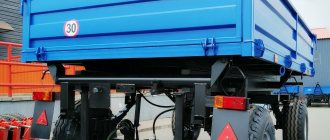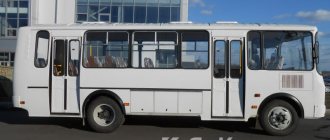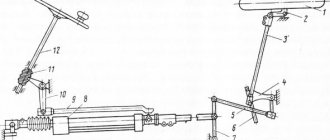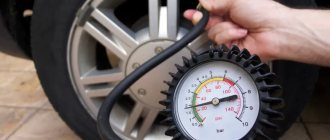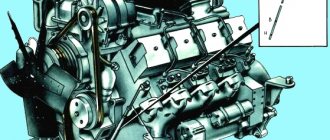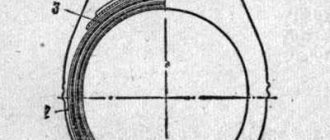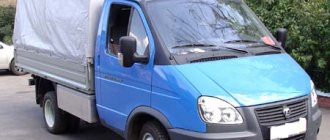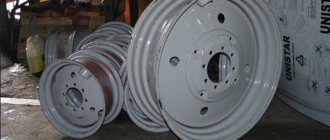As for me, I liked this interesting truck... especially when I read about it in the auto world...
LAWN NEXT Material from Wikipedia - the free encyclopedia
GAZon NEXT is a Russian truck in the family of the fifth (NEXT) generation of medium-duty trucks produced by the Gorky Automobile Plant. Description[edit | edit wiki text] The GAZon NEXT truck with a cab from GAZelle-Next has replaced the fourth-generation GAZ-3309 family, but for now it will be produced in parallel with it. GAZ C41R11 and C41R31 trucks with a load capacity of 5.0 tons and 4.7 tons are designed for use on all types of paved roads. For use in urban environments, modifications with low-profile wheels of smaller diameter are provided. Since 2015, it is also planned to release a new 3-ton off-road truck GAZ "Sadko NEXT" (4x4) with a single tire rear axle and a centralized tire pressure control system, and from 2016 - a 6-ton truck "GAZon NEXT" (4x2) with increased load capacity with a total weight of up to 12 tons with a dual-pitch tire on the rear axle. History of creation[edit | edit wiki text] Within the framework of the concept of a single “cab module “GAZelle-Next”, intended for installation on all bonneted truck models of the GAZ Group, within the framework of which the production of LCV “GAZelle-Next” has already been mastered since the spring of 2013, in 2014 AZ GAZ has begun production of the fifth generation of medium-duty trucks “GAZon NEXT” (according to the new factory numbering C41), which provides for broad unification of components and assemblies with vehicles in current production (primarily the cab and power plant). More spacious and ergonomically designed, including a height-adjustable steering column and modern seats, ventilation and heating systems, the modern 3-seater cab of the NEXT type brings Nizhny Novgorod medium-duty trucks to the level of foreign analogues (primarily made in the USA) and is similar to that used on the GAZelle light-duty truck. Next" (GAZ A21). In the near future, GAZon NEXT will also receive a double 7-seater cabin from the GAZ A22 GAZelle-Next. "GAZon NEXT" is initially equipped with disc brakes on all wheels with ABS and ASR. As a power plant, you can choose between an imported Cummins ISF 3.8 e4R turbodiesel or a new Russian-made YaMZ-5344-20 Euro-4 diesel engine with an upgraded 5-speed manual transmission capable of transmitting torque up to 500 Nm. The chassis and brakes have also been updated: new reinforced front springs 1600 mm long, maintenance-free cardan transmission, ZF power steering, WABCO pneumatic braking system, etc. Instead of standard wheels of size 8.25R20, the GAZon NEXT also provides for the installation low-profile wheels measuring 17.5 inches, which allows reducing the loading height from 1300 to 1170 mm.
On September 19, 2014, serial production of the new generation GAZon NEXT medium-duty truck began in Nizhny Novgorod. The symbolic start to production was given by Russian President Vladimir Putin, Chairman of the Supervisory Board of Basic Element Oleg Deripaska and President of GAZ Group Vadim Sorokin[1].
On October 24, 2014, the grand opening of sales of the commercial version of the GAZon NEXT truck took place in Nizhny Novgorod[2].
Specifications[edit | edit wiki text] YaMZ-534[edit | edit wiki text] Model YaMZ-53441
In-line, 4-cylinder, 4-stroke diesel engine, liquid-cooled, with turbocharging and charge air cooler, with direct common rail fuel injection, fourth environmental class (Euro-4).
displacement, l 4.43 compression ratio 17.5 power, hp (kW) / rpm 148.9 (109.5) / 2300 max. torque, N*m / rpm 490 / 1200-2100 specific fuel consumption, g/kWh (hp/h) - 197 (145) weight - 470 kg fuel: diesel fuel according to GOST R 52368- 2005 type II or III Upon request, the vehicle can be equipped with a preheater.
Cummins ISF 3.8[edit | edit wiki text] Model Cummins ISF 3.8 e4R
In-line, 4-cylinder, 4-stroke diesel engine, liquid-cooled, with turbocharging and charge air cooler, with direct common rail fuel injection, fourth environmental class (Euro-4).
Tire pressure for Gazelles Next
Very often, motorists and car owners of large vehicles wonder what the optimal pressure in gazelle tires should be inflated in order to increase the time period for tire replacement and at the same time optimize fuel consumption. The answer to this question can be given both by the technical recommendations of the manufacturer and by the personal experience of hundreds of thousands of users who share their thoughts on thematic forums.
Appearance Gazelle-Next
At high speeds, on a bad road, with many potholes on the asphalt, driving at speeds over 60 km/h and at full load, and even with overinflated tires, is dangerous because the tires are subjected to all kinds of exorbitant loads, which cause them to overheat. Shock loads are transferred to the disc and can even bend it, leading to air leakage and a flat tire. In addition, if there is a strong impact, the tire may become deformed (“a ghoul will come out”). As a result, you will incur unnecessary financial losses (buying a new tire, installing it at a service station). For a commercial vehicle this is an unreasonable expense.
What else you should know
The indicators are affected by ambient temperature and exposure to direct sunlight. Therefore, always inflate the wheels in a “cold” state, otherwise you will not be able to control the pressure level in them.
Distribute the load evenly - whether it is a Sobol-2217 with passengers or an onboard model with cargo.
Please note that every month the tire pressure decreases by 0.4 atmospheres, so do not forget to pump them up.
Manufacturer's official requirements
The Gorky Automobile Plant for its Gazelle Next trucks and buses assumes the following tire pressure indicators kPa (kgf/cm²):
It is worth considering that the new Gazelles use tubeless tires with stamped steel wheels. The rear axle has twin wheels, like those on trucks, to reduce the negative effects of overload on the tires. It is also worth considering that the maximum speed of new Next buses and trucks does not exceed 110 km/h, which makes it possible to use not the most expensive tires for a domestic truck.
Usually they try to install the most inexpensive components on the Gazelle, because this is a commercial vehicle, designed specifically for domestic conditions. It is relatively inexpensive and economical and can carry a relatively large amount of cargo.
The higher the tire pressure, the smaller the contact patch with the road surface, which means wear is also reduced, but much also depends on the operating conditions of the car (its load, type of road surface, weather conditions, driving style).
Additional seasonal markings
In accordance with many years of experience in operating cargo gazelles, drivers prefer to equip the vehicle with all-season tires. This decision is interpreted as a desire to save money on seasonal tire fitting, and the lack of space to store a second set of tires. The rear wheels are difficult to mount, since there are 4 of them.
Seasonal marking has the following designations characterizing the season and operating conditions:
- "M+S". Tires with a tread pattern for effective movement in mud and snow. They have a ground grip. These wheels for the Gazelle can be all-season or winter. If the marking does not include a snowflake design, then it is not recommended to use the tires in winter, only in summer.
- AS, AGT - all-season models.
- AW – for use in all weather conditions.
- Winter, snowflake pictogram - tires for the winter period.
- Aqua, Rain, Water or umbrella images - tires are designed to effectively drive on roads covered with water. Due to a specific tread pattern, water is drained away from the area where the tire contacts the road. At the same time, the maximum possible adhesion of the wheel to the road surface is maintained to ensure safe vehicle control.
- Studless - winter tires that are not subject to studs.
- Studdable - winter tires with studs or the possibility of such.
What do drivers suggest and what is the best way to proceed?
On thematic forums, owners and drivers of Gazelle Next cars were divided in opinion. For some, there are only technical requirements set by the manufacturer. For others, the higher the pressure, the better (some pump up to 4.0 kgf/cm² on both the front and rear axles), while others, on the contrary, try to reduce the pressure and pump up the ramps by only 3.5 kgf/cm². It is worth noting that reduced pressure makes sense on dangerous, difficult sections of the route (in icy conditions on a sandy country road or in mud).
However, with reduced tire pressure, they wear out much faster and in some cases will not last even 40,000 km. On the other hand, high blood pressure is also harmful. Not only will the car catch every bump and bounce like an old wooden carriage, but in some cases you can bend the disk from the impact on a bump or the tires will even “shoot off.” Ideally, it is better not to cheat, but to use the manufacturer’s recommendations in the range that he has determined for his products. After all, the cars underwent factory tests, during which the designers clarified all the nuances and features.
We recommend you look at: choosing tires for Gazelle.
Source
Parameters obtained experimentally
Drivers who often use GAZelle cars for work or for personal needs have determined the optimal parameters for themselves, which ensure a comfortable and safe ride in the car. Most drivers inflate their wheels to 3.5 atmospheres. Most often these are those who drive GAZelle-3302 and GAZelle-2705. This ensures a fairly rigid but confident ride both when the cabin is fully loaded with passengers or the body, and during empty flights.
Drivers of passenger minibuses (simply “minibuses”) know how much to pump the wheels of a GAZelle for a comfortable ride on less than ideal roads in Russian cities. Since the suspension of such cars is quite rigid, the tires should not be inflated to a “rock” state. Minibus taxi drivers, in their own words, pump the wheels to a “three-point state,” that is, to a pressure equal to 3 atmospheres.
Factors influencing the choice of tire pressure are determined by both operating conditions and technical characteristics of the rubber.
- Tires must have markings indicating the maximum load that the rubber can withstand.
- An important factor will be the estimated maximum load of the car: how many people will be packed into the cabin or what type of cargo will be transported.
- All wheels must be inflated evenly. Differences in values between the axes should not exceed 0.8 atmospheres. Between the wheels of one axle - no more than 0.3 atmospheres.
- It is necessary to check the tire pressure with a pressure gauge at least once every two weeks, since the natural loss is 0.4 atmospheres per month.
Specifications
dimensions
Car C41R11, C41R13:
A=2400 mm (for a car with 8.25 R20 tires);
A=2335 mm (for a car with 245/70R19.5 tires);
H=2755 mm (for a car with a standard platform);
H=2960 mm (for a car with a larger platform);
С=2290 mm (for a car with a standard platform);
С=2550 mm (for a car with a larger platform);
D=1709 mm (for a car with a standard platform);
D=1849 mm (for a car with a larger platform)
Car C41R31, C41R33:
A=2400 mm (for a car with 8.25 R20 tires);
A=2335 mm (for a car with 245/70R19.5 tires);
H=2755 mm (for a car with a standard platform);
H=2960 mm (for a car with a larger platform);
С=2290 mm (for a car with a standard platform);
С=2550 mm (for a car with a larger platform)
Car C42R31, C42R33:
A=2400 mm (for a car with 8.25 R20 tires);
A=2335 mm (for a car with 245/70R19.5 tires);
H=2755 mm (for a car with a standard platform);
H=2960 mm (for a car with a larger platform);
С=2290 mm (for a car with a standard platform);
С=2550 mm (for a car with a larger platform);
D=1709 mm (for a car with a standard platform);
D=1849 mm (for a car with a larger platform)
Total information
| Options | Automobile model | ||||||||
| С41R11 | С41R31 | С42R31 | |||||||
| Number of seats (including driver), persons | 3 | 3 | 7 | 3 | 3 | 7 | |||
| Total weight, kg | 8700 | 8700 | 8700 | 8700 | 8700 | 8700 | |||
| Weight of the equipped vehicle, kg | with platform without awning | 3600 | 3995 | 4020 | 3730 | 4130 | 4150 | ||
| with platform and with awning | 3700 | 4145 | 4120 | 3930 | 4280 | 4250 | |||
| Vehicle load capacity, kg | with platform without awning | 5100 | 4705 | 4680 | 4870 | 4570 | 4550 | ||
| with platform and with awning | 5000 | 4555 | 4580 | 4770 | 4420 | 4450 | |||
| Ground clearance (at full weight), mm | 253 | 253 | 253 | 253 | 253 | 253 | |||
| Minimum turning radius along the track of the outer front wheel, m | 8,2 | 9,6 | 9,6 | 8,2 | 9,6 | 9,6 | |||
| Control fuel consumption (measured using a special method) when driving at a constant speed, l/100 km: | 60 km/h | 14,3 | 14,3 | 14,3 | 13,6 | 13,6 | 13,6 | ||
| 80 km/h | 19,3 | 19,3 | 19,3 | 18,0 | 18,0 | 18,0 | |||
| Maximum vehicle speed on a horizontal section of a flat highway, km/h | 105 | 105 | 105 | 105 | 105 | 105 | |||
| Overhang angles (with load), degrees. | front | 30 | 30 | 30 | 30 | 30 | 30 | ||
| rear | 18 | 12 | 18 | 18 | 12 | 18 | |||
| Maximum incline overcome by a vehicle with a full load, % | 30 | 30 | 30 | 30 | 30 | 30 | |||
| Loading height, mm | 1300/1165* | 1300/1165* | 1300/1165* | 1300/1165* | 1300/1165* | 1300/1165* | |||
Note
: * For a vehicle with 245/70R19.5 tires.
Engines
| Model | Cummins ISF3.8s4R154 | YaMZ-53441 | |
| Type | Diesel, with turbocharging and charge air cooler | Diesel, with turbocharging and charge air cooler | |
| Number of cylinders and their location | 4, in-line | 4, in-line | |
| Cylinder diameter and piston stroke, mm | 102x115 | 105x128 | |
| Cylinder displacement, l | 3,76 | 4,43 | |
| Compression ratio | 17,2 | 17,5 | |
| Maximum power, kW (hp) | 112 (152,3) | 109,5 (148,9) | |
| at crankshaft rotation speed, rpm | 2600 | 2300 | |
| Maximum torque, net, Nm (kgfm) | 491 (50,1) | 490 (49,9) | |
| at crankshaft rotation speed, rpm | 1200-1900 | 1200-2100 | |
| Cylinder operating order | 1-3-4-2 | 1-3-4-2 | |
| Crankshaft rotation speed in idle mode, rpm | minimum (nmin. xx) | 750±50 | 700±50 |
| increased (np. xx) | 2950 | 2800 | |
| Direction of rotation of the crankshaft (observed from the fan side) | Right | Right | |
What tires can be installed on a Gazelle on the rear axle?
When choosing new tires, the manufacturer strongly recommends installing tires of the same type and size. The requirement is justified by the minimum gap between the slopes in the working pair. When loaded, the distance between the sidewalls decreases (the cylinders are pressed through), which requires maintaining the original characteristics of the product.
In some cases, car enthusiasts independently convert the car’s axle to accommodate single wheels. Tuning improves the following indicators:
- permeability;
- fuel efficiency;
- savings on tires (fewer quantities need to be purchased);
- improved dynamics.
Among the disadvantages, the reduction in carrying capacity stands out - the twin coupler can withstand a greater load. There is also the risk of a puncture; if you puncture a wheel on a double unit, the second part will withstand the trip to the service station.
Payment via Yandex Cashier
After selecting payment via Yandex, the Yandex Cashier payment system will launch, where you need to select a convenient payment method (bank card, QIWI, Yandex Money account, etc.)
After specifying payment details and confirming payment, payment for the goods will occur.
If you have a bank card in a currency other than the ruble, then the money will be debited from the card at the rate of the Central Bank of Russia at the time of the purchase.
This payment method is optimal for residents of Russia, Kazakhstan and Belarus.
Official website of the Yandex Kassa payment system https://kassa.yandex.ru
What tire sizes does the manufacturer recommend to install?
ATTENTION! A completely simple way to reduce fuel consumption has been found! Don't believe me? An auto mechanic with 15 years of experience also didn’t believe it until he tried it. And now he saves 35,000 rubles a year on gasoline! Read more" The tire size depends on many factors: wheel formula, year of manufacture, engine modification
A relatively old model is the GAZ-2705. It has a 4×2 wheel arrangement. Hub diameter – 130 mm. Standard wheel parameters:
- tire modification – 185/75 16C;
- disk size – 5.5J×16 ET106;
- drilling – 6×170 mm.
For vehicles with a 4×4 wheel arrangement, the tire size is slightly different. The width of the “sole” should be slightly larger. This is a prerequisite for normal contact between the wheel and the road. Standard wheels for a GAZ-3221 car with a 4×2 wheel arrangement:
- hub diameter – 130 mm;
- type of disk used – 5.5J×16 ET106;
- tire – 195/75 mm.
There are 7 different versions of the GAZelle car. The latest modification is a machine labeled Next. It has a 4×2 wheel arrangement and the following main characteristics:
- tire – 185/75 mm;
- disk – 5.5J×16 ET106;
- drilling – 6×170 mm.
Using wheels that meet standard parameters will make the car more controllable and avoid premature wear of chassis parts. There are many different subtleties and features of choosing wheels. If you do not have sufficient experience, you should use the help of specialists.
Payment via Portmone
After selecting payment through Portmone, the payment system will launch, where you need to select the payment method: bank card or Portmone account.
The price in the Portmone payment system is converted into dollars at the exchange rate of the Central Bank of the country where you are located.
If you have a bank card in a currency other than the dollar, then the money will be debited from the card at the rate of the Central Bank of your country at the time of the purchase.
After specifying payment details and confirming payment, payment for the goods will occur.
Official website of the Portmone payment system https://www.portmone.com
Payment via PayPal
After selecting payment via PayPal, the PayPal payment system will launch, where you need to select the payment method: bank card or PayPal account.
If you already have a PayPal account, then you need to log into it and make a payment.
PayPal will then prompt you to select your country and provide your credit card information.
After specifying the information required to make the payment, you must click on the “Pay Now” button.
Official website of the PayPal payment system https://www.paypal.com
Payment via WebMoney
After selecting payment via WebMoney, the payment system will launch, where you need to select the payment method: bank card or WebMoney wallet.
If you already have a WebMoney wallet, then you need to log into it and make a payment.
If you do not have a WebMoney wallet and you want to pay in another way, you need to select any of the methods that WebMoney offers and make the payment
After specifying payment details and confirming payment, payment for the goods will occur.
Official website of the WebMoney payment system https://www.webmoney.ru/
Downloading a book
After successfully completing the payment (by any method) and returning to the KrutilVertel store from the payment system website, you will be taken to the successful payment page:
On this page you need to indicate your e-mail, where access to download the book will be sent.
If you are already registered on our website, then simply follow the link to your personal account.
The book you purchased will be in your personal account, from where you can always download it.
Please note that after making the payment, you need to return back from the payment system website to the KrutilVertel website.
Lawn Next 10 Test — DRIVE2
Good time everyone!
So, we spent five days with Next 10. You can summarize and express your thoughts out loud.
I wanted to record a video, but lack of time and the heat took their toll. I started recording video, the phone began to overheat and turn off the camera. Everything will have to be done in your own words.
Where it all started. A little preface.
Before this Lawn, in addition to many passenger cars, I managed to have experience with many commercial cars. Among them were Sprinter 413, Boxer, Daf 95, Volvo Fh22, transit, several gazelles, Starex, bull, 3307, Maz and others. For the last four years I have been driving an NP75 from 14th century. My opinion is based only on personal experience. If I don’t know the car, I won’t prove anything good or bad about it. I won’t shout phrases like: “For this money, I’d rather take a five-year-old, etc!” or “You’d have to be a fool to buy this bucket!” No.
Everyone has their own opinion, the amount of money for a car that they can afford and their own experience. If experience is not enough, then a person will acquire it with the purchase of this car. Good or bad. Do not forget that the same car (identical) will only cause problems and negativity for one person, while a neighbor will admire the same car. Recently this happened!) I went to Mega, there was Next 8.7. If I have time, I try to drive up and find out some information about the car. Literally, the driver’s response is “Oh@enn@! I like! Later, driving out from the other side, I stopped at another one - “H@rn@! I do not advise!" So much for contrasting opinions with a difference of 400 meters. What I want to tell you is, rely only on your opinion. Everything I describe here is mine, personal.
So. It all started with the release of the first NEXT lawn. It turned out to be quite an interesting car. Even then I was thinking about buying it. But there were reasons why I didn’t do this. Later it turned out that this was even for the better. Alas, the guys had to suffer with the first games. There were problems with radiators, turbines, and a large turning radius. The 20th wheels were changed to 19.5. Many complained about the rattling gearbox lever. In general, there were quite a few problems. Slowly, some of the problems were eliminated by the plant.
What we see today... Lawn Next 10.
First of all, ten! Ten-tonner! The first question many people ask is, is he carrying 10 tons, or what?!
No. This is its permitted maximum weight. The chassis load capacity is 5.7 tons. In the finished version, minus the weight of the booth or tent body. These are the numbers we will have in the vehicle passport. In fact, on average, they carry 5-5.5 tons. Moreover, this is on Lawn 8.7. They carry more, this is an average figure that can often be heard. This car has the following numbers in its passport: 10000/5583 kg.
Today, Lawn 8.7 is not that uncommon on the roads. But 10 is not yet visible. Many times I looked at it in photos, but when I saw it in person... The first thing that came to mind was: What a hippopotamus!
Yes, because of the swollen wings, he began to look even more massive and more brutal. At one of the traffic lights, a man from a neighboring car ran up to me. “Is this already new?!” What?! How?! Looks really cool!” With these same words, without waiting for an answer, he ran back.
What differences does it have from Lawn 8.7?! There are quite a lot of them. But outwardly they can only be distinguished by the front fenders and the nameplate on the door. Although there were no dozens on the test machine.
The wheelbase of the front axle was extended on 10. The front wheel is now level with the outside rear wheel. This had a very positive effect on handling and stability. Everything is fine with the steering wheel turn too. I didn't notice any discomfort. The turning radius is quite adequate. I made a U-turn once on a two-lane road. Using a shoulder that was about a meter and a half wide, I was able to do it easily in two times.
The rear suspension is now on air springs paired with a semi-spring.
The body level sensor is located on this beam spring. There have already been comments about it online, saying there may be problems with it in winter. But this is still all theory and speculation. Because 10th Lawn has not yet seen winter. I believe that problems should be solved as they come, rather than designed.
By itself, the suspension fulfills all its purposes. But there were some complaints. We'll touch on them later.
Its control unit is located on the driver's seat.
Although I did have one question about it. I never managed to find out completely. The fact is that if you lower the suspension to the lower position and turn off the car, then after the ignition key is subsequently turned, the car itself moves into the transport position. And there seems to be no problem... But why is this bad?! Let's say we need to unload under some kind of canopy or arch, but the body passes under it only in the lowered state. It turns out that if we turn off the car in this position, we will fall into a trap as soon as we want to start the car in order to leave. It is possible that this point can be solved with memory buttons. To be honest, I had a similar unit on my DAF, but I never used these memory buttons. On/off and up/down, everything I needed from it.
Everything else is good. Even with 5 tons of cargo, the car moves very confidently and does not sway, unlike spring ones. I haven’t driven the 8.7, but I can compare it with the Japanese five-ton trucks.
The wheels are factory installed R19.5, with tubeless tires. You can take a deep breath from this fact alone! Come on, buy six new assembled wheels?!
By the way, you can pay attention to the tires. “Belshina” was installed on “my” Lawn.
I had never had the opportunity to deal with her before. What does it feel like... In general, it’s quite normal tires. Straight, the tread is not narrowed and quite high. Looks good.
I didn’t really have a chance to drive it in the wet, but I have no complaints about it in the dry. I noted only two shortcomings. At speed it doesn’t “sing” much and throws stones quite hard at the arches. The price tag on the network is about 12,000 rubles.
Another innovation is located in the cabin. Namely, the gearshift lever, which is popularly called a joystick. Yes, now instead of a rattling, long poker, there is a joystick on the panel.
The gears shift without any problems. No snacking or crunching. Everything is quiet while driving too. This device will be especially good for those who have a car with a sleeping bag. No obstacles on the floor on the way to the sleeping bag.
Do I need to change tires on a Gazelle?
Some drivers prefer all-season tires, but this is only relevant in certain regions.
Winter tires for Gazelle
Winter tires for a Gazelle car are practically no different from modifications for conventional cars. Here are the general traffic rules and customs union standards, which clearly state that you need to install winter tires for the period from December to early March, regardless of the region.
The tires themselves are divided into two categories:
- friction;
- studded.
Both versions can be installed at the request of the motorist and the actual operating conditions of the car.
Is it necessary to install studded tires on a Gazelle?
Some users are wondering whether it is worth installing winter tires with studs on the Gazelle.
The answer to the question will be the region and area where the car is driven. If the car is driven primarily in urban areas, the roads are well cleaned and there is no heavy icing, a standard friction clutch will fully cope.
When driving on the highway or in small towns where there are problems with cleaning the road surface, you will need to install studded tires. Regular Velcro can slip on ice or in the presence of deep lines.
It is not recommended to deviate from the factory settings in terms of width. Wide modifications brake worse and are less stable when negotiating sharp turns.
- Nokian;
- Goodyear;
- Rossava;
- Michelin.
You can also pay attention to the offers of domestic manufacturers
What all-season tires to put on a Gazelle
As an all-season vehicle, motorists are offered options exclusively produced in the CIS. In Europe, the USA and Japan there is no concept of “all-season tires”. Therefore, it will not be possible to find a universal imported tire.
- Belshina;
- Rossava.
Also good reviews of other offers.
what should be in the wheels
The domestic company GAZ produces several variations of cars on one platform. The recommended pressure in GAZelle tires also depends on this parameter. The difference is due to the difference in the load on the wheels. For example, a light onboard version without a load can get by with 2.6-2.7 kilograms, while a heavy passenger-type vehicle requires 3.0-3.5 At for the front and rear tires.
The amount of air in tires is also affected by the area of application and the time of year. As an example, we can cite two identical cars operating on asphalt and dirt. The first option requires a working pressure of 3.5 At, this is justified by the hard coating and the absence of the need to increase the contact patch. For the second option, the norm is 2.6-2.8 At, which is due to a soft road with poor grip.
Separately, you should pay attention to the time of year. In winter, tires need to be inflated more than in summer, but the pressure inside the wheels may be the same. The peculiarity is caused by frost - the air becomes denser as the temperature drops, which causes a drop in pumping.
Tire pressure GAZelle-Next
The company's innovation was a supercharged diesel engine, installed instead of the old gasoline version of the internal combustion engine.
According to the car's passport, the recommended inflation for GAZ Next tires is 3.8-3.9 At. This parameter is relevant on buses where the total axle load is less than 5 tons. The cargo version differs from the city pass modification. The applicable parameters here are 4.0/2.5-3.9 for the front and rear axles, respectively. A wide spread for twins represents thresholds for empty and loaded vehicles.
Where to check tire pressure
Optimally, the inside of GAZelle tires should be 3.8-3.9 At. It's better to look at the operating instructions. The book is supplied to the market complete with the machine and contains all service information.
The second option is tire markings. On the sidewalls of the tire, manufacturers indicate the recommended inflation for the front axles, and twin axles - as a rule, the indicator is different.
Tire pressure for GAZelle 3302
Optimally in the Business 3.0 At version in a circle for all wheels. However, the nominal value may vary depending on the modification of the machine and the load.
In the flatbed model with an awning, where the length of the body is limited to 3 m, the front pair remains unchanged. The rear wheels require constant monitoring. When the trunk is empty, it is allowed to reduce the figure to 2.7 At, and when loading over 1.5 tons, 4.0-4.5 kg is considered the norm. The loaded indicators include a van and a version with an extended body of 4 meters. Here, due to the large mass of the car itself, it is not recommended to lower the inflation bar for an “empty” car below 3 kg.
The curb weight of the economy modification is practically the same after restyling. Therefore, tires can be inflated equally.
Tire pressure GAZelle 33023
For the cargo modification of the “Farmer” vehicle, the inflation inside the tires recommended from the factory is 3.0 kg. When the body is fully loaded, it is necessary to raise the value to 4.0-4.5 At. The extended version also falls into this range - the load capacity of the vehicles is the same, and the weight of the body in this case can be neglected.
Single wheels on GAZelle
In Nizhny Novgorod, they are designed for increased loads, and they are often equipped with reinforced springs on the rear axle, in order to reduce the pressure on the ground, thereby preventing damage to the roadway and increasing load capacity. However, this way of solving commercial problems is not always rational for many drivers for the following reasons:
- First of all, the general base of the GAZelle, even with a reinforced frame, remains the same, and it is more rational to use single wheels to increase the service life of the car if they have the required tire size for the GAZelle.
- The single-slope version significantly increases cross-country ability, specific adhesion to the road surface, improves controllability and, accordingly, significantly reduces the risks of breakdowns and accidents during long hauls of cargo across the country.
- It should also be remembered that single-ply tires are much more economical for vehicle owners, and the costs of their installation and repair will be significantly lower.
- Due to lower rolling resistance, the car can reach higher speeds or accelerate faster, and fuel consumption is not 5%-10% lower, which provides significant savings over several years of commercial transportation.
- The total load capacity in the case of choosing a single-pitch tire drops slightly, and the vehicle can transfer a load of almost the same mass at lower costs.
Important!
If we consider the operation of heavy-duty vehicles, then they simply need dual-ply tires, but in the case of the GAZelle, any operator can completely get by with single-ply tires with a dimension of 185/75/R16C, and these parameters will be most beneficial for the owner.

